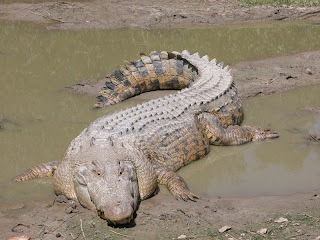 The Saltwater or Estuarine Crocodile (Crocodylus porosus) is the largest of all living reptiles. It is found in suitable habitats throughout Southeast Asia and Northern Australia. The Bhitarkanika National Park on the Orissa coast, India has achieved the rare distinction of housing the world's largest estuarine or salt water crocodile, locally known as (Baula Kumbhira), measuring about 23 feet.
The Saltwater or Estuarine Crocodile (Crocodylus porosus) is the largest of all living reptiles. It is found in suitable habitats throughout Southeast Asia and Northern Australia. The Bhitarkanika National Park on the Orissa coast, India has achieved the rare distinction of housing the world's largest estuarine or salt water crocodile, locally known as (Baula Kumbhira), measuring about 23 feet.The largest crocodile of Bhitarkanika has found a place in the 2006 edition of the Guinness Book of World Records. The latest census carried out by the wildlife division indicated that the Bhitarkanika sanctuary has a total strength of 1462 crocodiles which included 203 adults.
Bhitarkanika has also emerged as the ideal habitat for the salt water crocodile in the country and also the largest concentration. Though Sundarbans sanctuary has a good mangrove forest, yet it houses a very small population of the salt water crocodiles. So is the case of Andaman and Nicobar Islands.

The saltwater crocodile is stated to be most dangerous species of crocodilians from a human stand point . In the Bhitarkanika Wildlife Sanctuary (now a National Park) all the ingredients for human attack exists. Particularly, frequent human intrusion into the crocodile habitat illegally and a crocodile population in the Sanctuary containing a good number of very large males. But it has been observed that the adult crocodiles under normal circumstances never leave their territory to chase the human beings on land unlike terrestrial predatory animals like tigers, etc. Most of the human attack incidents occur when the victims enter into the crocodile habitat either for illegal fishing, poaching, collection of wood, honey, nalia grass etc. from the river or creek banks or while setting the traps or noose for trapping the deer, wild boars, etc. very close to river or creek banks.
A programme for conservation of estuarine crocodile and its habitat was started at the Bhitarkanika National Park in the year 1975 by Dr. H.R Bustard, the FAO/UNDP Consultant. As a result of this and other measures, now the status of this crocodile is of Least Concern (IUCN 2.3).
Latest update: As per the 2008 census report, carried out by the wildlife division, there has been a marginal but proportionate growth of these crocodiles with 1498 of them found inhabiting in and outside the Bhitarkanika wildlife sanctuary. The figure was 1482 last year. The outstanding feature of this year's census was that as many as ten adult and sub-adult white crocodiles were found inhabiting these water bodies.
